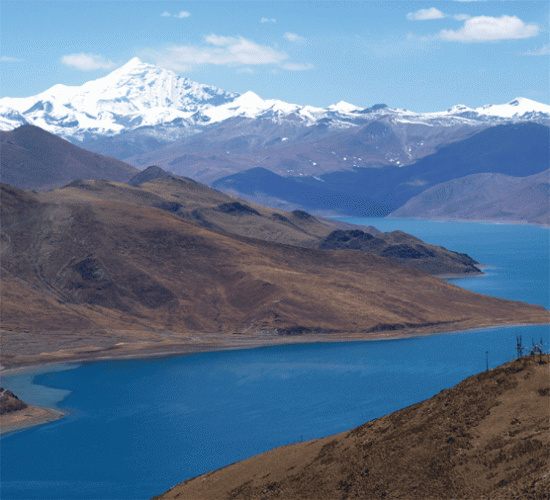
Text & photos by Brian Braude
Tibet was "liberated" by China in 1950 and today is an autonomous region under the very heavyhanded rule of the Chinese. The presence of two Chinese troops on every corner in Lhasa and patrols of a squad of six troops every fifty meters in the markets, are constant reminders of the conditions under which the Tibetans live.
Tibet had been closed to foreigners during the six weeks prior to our trip due to anticipated demonstrations against Chinese rule. The border was expected to open before our planned visit. In the end, our permits and visa arrived just hours before we departed by minivan from Kathmandu. We were a group of seven: a young Canadian of Chinese decent, a young Swiss couple and our group of four old guys. We are four friends, who, for the past twenty years have spent our Friday and Saturday mornings running together, and more recently have taken to ending our Saturday run with coffee and a croissant at Arcaffe. Of late we run less but compensate by talking and croissanting more. Surprisingly, this appears to burn less calories with the result that some of us are now seemingly in the late stages of pregnancy.
It's only about a hundred kilometers from Kathmandu to the Tibetan border, but a five hour trip on Nepali roads. Ugg. One approaches the border by climbing up a narrow steep valley whose last few hundred meters are a dingy Nepali village looking dirtier than most. The valley ends with a steep cliff rising high above the border post and ones first view of Tibet is a village hanging on the side of the cliff face like a painting hung on the wall of an art gallery. The border crossing is a little intimidating with an excess of formality and unsmiling Chinese officials. However, dour Chinese officials were compensated for by the ear to ear smile of our Tibetan guide and drivers who were patiently waiting for us next to their jeeps.
We were driven to the "wall hanging" village where we had lunch and then "rested" for five hours, as the road was closed due to what our guide described as "exploding roads", which, when liberally translated, means construction work. We finally arrived at a small village perched on the very top of the cliff at a height of 3700 meters above sea level. We had been warned by our Nepali travel agent that the accommodation for the first two nights was very basic and he didn’t lie. At least not about this. The four of us together in a tiny freezing room. No showers, a tap in the yard and a common toilet that makes you wish you were constipated. In addition, we were worried about the large gain in altitude from our previous night in Kathmandu (We had climbed 2500 meters in one day.) and bought canisters of oxygen just in case. Fortunately we all felt fine.
There were at least 20 other jeeps doing the same trip as we were, resulting in our bumping into the same people from time to time on the way to Lhasa: a family from Australia, an elderly couple from Moscow, two young guys from the States who were studying medicine in Tel Aviv, a young man from England who immediately told us that his father was Jewish. We were able to chat to them at the hostels and small restaurants when we met in the evenings. This helped pass the time while waiting for our meal to arrive, as about 80 people trying to eat in a restaurant with 30 odd chairs, means a long wait, muddled orders but lots of green tea and conversation.
Day 2 was spent driving through the Tibetan plateau which is a desert at a height of 4000 meters. The scenery was nothing special and night two was again spent in a cozy room for four with similar bathroom facilities as night one, at a height of 4400 meters. I woke at about 2 a.m. needing to go to the toilet, but as it was freezing outside I prayed that my bladder would allow me to fall asleep again. After waiting for as long as I could, I crawled out from under the eiderdown, put on my coat and boots and went out into the cold very thin night air. My head began to swim and I crumpled onto the freezing ground. After a few seconds with my head still feeling like a roller coaster, I got the message that I had to get up. I staggered to the middle of the yard where neither my head nor my bladder would allow me the luxury of going any further. I got back to bed after bumping into and waking up my room mates. A little cursing and we all went back to sleep.
There is only one time zone in China, and so in Tibet, which is in the west of the country, sunrise is late and we would only set off by about nine thirty a.m., in the hope that the air would warm up a little by then, especially as the sky was so perfectly clear.
Day 3 allowed us some wonderful views of the surrounding snowcapped mountains with Mount Everest and three other eight thousand meter peaks being clearly visible next to each other. Four of the twelve highest mountains in the world standing on a desert plateau that itself was 4500 meters high is a sight not to be forgotten. Everest, Makalu, Lhotse. These were mountains that I had read and dreamed about. Mountains that have made people famous but have also claimed lives. We felt very privileged to see these giants. Yaks pulling primitive wooden ploughs, men and women working the land in expectation of the coming rains and snotty nosed children playing next to the road, all added to the feeling that I was in a dream.
We arrived in Xigatse, the second largest town in Tibet, in time for a late lunch and a hot shower before setting off to visit the famous Tashilhumpo Monastery. The monastery was built in the 15th century and is the traditional seat of the Panchen Lama, the monk second in importance only to the Dalai Lama. The temples, shrines and assembly halls, which once held thousands of monks, are grandly decorated with wall paintings, cloth hangings and gold and silver statues. Shelves hold ancient scripts, some beautifully illustrated by monks hundreds of years ago. The golden domes reflect the harsh sunlight in contrast to the dark interior of the buildings. The few hundred monks now living in the monastery need special permits to become monks and are there at the discretion of the Chinese authorities. The pilgrims make offerings of money to every picture and statue, and yak butter is added to the hundreds of yak butter lamps that light up the dark interior of the windowless rooms. Everything seems covered with a thin layer of yak butter and the burning lamps give off a strong smell. Eerie? Spiritual? Definitely memorable.
It is believed that when the Panchen Lama dies, he is reincarnated once again as the next Panchen Lama. The identity of this new Panchen Lama is determined by a complicated process carried out by senior monks. The 10th Panchen Lama died in 1989, the cause of death being either a heart attack or poisoning, depending on who one asks. The selection of the 11th Panchen Lama was sure to be problematic. Would he be chosen by the Tibetan clergy including the Dalai Lama or by the Chinese authorities? Once the identity of the young Eleventh Panchen Lama, chosen by the Dalai Lama, was made public knowledge, he and his family were flown to Beijing by the Chinese authorities, and there disappeared, his whereabouts, twenty years later, still unknown. Another young boy was appointed by the Chinese instead.
Day 4 was spent in the small town of Gyantse seeing another monastery and wandering around the Tibetan quarter of the town. Almost every house has a yak, a cow or a goat tethered outside in the small yard in front of the house and, as the area is off the normal tourist track, people are friendly and open, resulting in our being invited into a few of the houses. In an effort to make Tibet an integral part of China, hundreds of thousands of ethnic Chinese have been encouraged, with financial incentives, to move to Tibet. Thus, towns in Tibet have a larger, more modern Chinese quarter and an older, less developed, traditional Tibetan quarter. The two areas and their respective residents lead parallel lives.
Day 5 was the scenic highlight of our trip as we drove around the sacred Yamdrok Tso or Turquoise Lake situated at 4500 meters and surrounded by lofty mountains. The lake is sacred to the Tibetans and they are forbidden to even touch its waters. This, however, didn't stop some Chinese entrepreneur from opening a fish restaurant on its shore and using two fishing boats to keep his restaurant supplied, something equivalent to using the Wailing Wall as a pub, if one is to judge by the emotional reaction of our guide. It gave us a glimpse of his real feelings towards the Chinese.
Crossing a pass high above the lake but at the foot of even higher snow covered mountains, we stopped to take pictures of a family working hard to build their house at well over 5000 meters. How could a lone family survive in this totally unfriendly environment, surrounded only by the thousands of colored prayer flags, hung at every pass, flapping in the brisk breeze, sending the prayers written on them high into the sky. The famous Brahmaputra river starts off high up in the mountains of Tibet, but as it was the end of the dry season, what we saw was only a shadow of this mighty river which later joins the Ganges river to form the largest delta in the world.
We reached Lhasa in the late afternoon, entering through the Chinese part of town, with its modern shops and wide boulevards and were taken to our hotel on the main street of the Tibetan quarter. What a surprise – a really great hotel and much more than we had gotten used to or expected. For me Lhasa was the main reason for coming on this trip. It was probably the most mysterious city in the world until only a few decades ago, a city I had seen in movies and read about in books. Finally I would see it in the flesh. We were all tired after a long day but I was too excited to shower or rest and set off to explore. I have met many Tibetan people in Nepal and in India. I have even been blessed by the Dalai Lama in Dharamsala, but here everything seemed more vivid, more concentrated, more powerful.
The narrow alleyways were lined by houses whose style was almost the same throughout Tibet - square houses built of whitewashed stone with a wooden door and window frames which were highly decorated in bright colors. The women dress in full length dark wrap-around dresses with colorful striped aprons in front. Around their waists are belts with large intricate silver buckles and beads of red coral or turquoise which add further color to their hair and necks. The men often grow their hair long and braid it with a red ribbon, winding this black and red plait around their heads. They are dressed in layer upon layer of western clothes, often with the addition of a long wrap around coat, which may or may not be lined by sheep skin. The old people are particularly attractive: deep wrinkles, bent backs, elongated faces. A photographer’s paradise.
The narrow market streets almost all lead to the Barkhor, a pilgrim's walk, which winds through the alleys around the Jokhang temple, the holiest temple in Tibetan Buddhism. Every day thousands of people walk this circuit, going around and around the temple while fingering their strings of prayer beads and chanting prayers and mantras as they make their way past the hundreds of shops and stalls that line the alleyways. Giant blocks of yak butter, musical instruments, religious objects, clothes, jewelry, tourist souvenirs, half a dried sheep - in fact, anything and everything.
Inside the temple thousands of pilgrims come to pray and make offerings, asking that a sick child be healed or that they should do well at school. From the rooftop, the view is wonderful – the golden domes of the temple itself, the adjacent Barkhor square, the circumambulating pilgrims and the magnificent Potala palace in the distance.
Our last day in Lhasa started with a visit to the Potala Palace, previously the seat of government and the home of the Dalai Lama. Situated on the top of Red Mountain, 130 meters above the town and rising up another 13 storeys, it is the landmark of Lhasa. Its more than one thousand rooms built almost four hundred years ago, took thousands of builders and artists more than fifty years to build and decorate. From the outside, the main body of the building is white, the part set aside for secular activities, while rising from its center are the ochre colored religious buildings. The inside is lavishly decorated with precious stones, paintings, wood carvings and literally tons and tons of gold and silver. It is overwhelming and our visit ended all too quickly.
After lunch we had another monastery to visit but in truth we were "templed out" and anything after the Potala palace must be a letdown.
But first lunch, which we decided to take in a small Tibetan fast food "restaurant" near our hotel. There were four or five formica tables in a small shop and the cook was doing his thing behind a low partition. On the wall are appetizing pictures of what he can prepare and we look at the menu, written in Tibetan but with roman numerals, to get an idea of how much we are letting ourselves in for. Nothing costs over three dollars. The food arrives. They must be Ashkenazi Jewish Tibetans. There is a thupka - vegetable noodle soup, momos which looked and tasted just like my Boba's kreplach, and various other, less Jewish, delicacies. We skipped the tea made from yak butter, salt and tea leaves and settled for bottled water and the bill. An initial misunderstanding regarding the bill caused our jaws to drop. We thought she meant fifty dollars when in fact she wanted five. Yes, five dollars for great food for four hungry men.
Our Tibetan trip was over. Well almost. We arrived at the airport the next morning ready to fly back to Kathmandu. We checked our bags in at the airline counter, when one of us was called to the screening machine behind the check-in clerk. They had found a bullet in his bag. My heart stopped as I imagined him spending the next few months in a Chinese jail and me having to explain to his wife why he had not returned home with us. The next hour and half crawled by and eventually after being questioned by a panel of five policemen as to why he had the bullet and where it came from, he was sent on his way with an apology that he would not be able to take the bullet with him as it was against international aviation law.
The flight itself was spectacular. Above or at times next to the highest mountains in the world, covered in snow and looking so peaceful. An ideal memory to end a dream holiday.
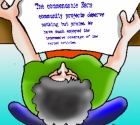 DEAR EDITOR 152
DEAR EDITOR 152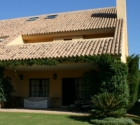 TIDBITS, COMMENTS AND ODDITIES-152
TIDBITS, COMMENTS AND ODDITIES-152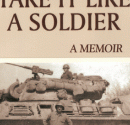 TAKE IT LIKE A SOLDIER - A MEMOIR - A Review
TAKE IT LIKE A SOLDIER - A MEMOIR - A Review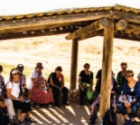 From Bible to Bedouins and Battles
From Bible to Bedouins and Battles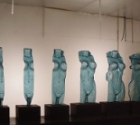 Trip to the Dead Sea
Trip to the Dead Sea Japan
Japan Brian Braude
Brian Braude